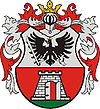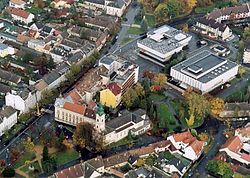- Nagykanizsa
-
Nagykanizsa 
SealLocation of Nagykanizsa in Hungary Coordinates: 46°27′N 16°59′E / 46.45°N 16.98°E Country Hungary County Zala Government – Mayor Péter Cseresnyés (FIDESZ-KDNP) Area – Total 148.40 km2 (57.3 sq mi) Population (2011) – Total 49,850 – Density 334.35/km2 (866/sq mi) Time zone CET (UTC+1) – Summer (DST) CEST (UTC+2) Website nagykanizsa.hu Nagykanizsa (Hungarian pronunciation: [ˈnɒɟkɒniʒɒ]; Croatian: Kan(j)iža, Velika Kan(j)iža; German: Großkirchen, Groß-Kanizsa, Slovene: Velika Kaniža , Turkish: Kanije) is a medium-sized city in Zala County in southwestern Hungary. It is also known in Hungarian as Kanizsa.
It lies not far from Lake Balaton at the meeting point of five routes. For centuries the town has been a connecting link. Goods from Slovenia were transported to Graz via Nagykanizsa, and the town played an important role in the trade from the Adriatic Sea to the Alpine region, Vienna, and Budapest.
Contents
History
The city's oldest Roman era ruins were uncovered in the 1960s. Later, during the Middle Ages, it became one of the most important strongholds of the Hungarian Kingdom. The fortress had a significant role in the southern shield line of Hungary, keeping the whole of Western Europe safe from the attacks of the Ottoman Empire. Instead of conquerors, today Nagykanizsa attracts thousands of dental tourists as the modern age's invaders. The name Kanizsa is of Slavic origin (Knysa), and means "belonging to a prince". It refers to the fact that the region was the property of an aristocrat.
The name Kanizsa was first mentioned in a document in 1245. The Kanizsai family continued building the castle and constructed a rectangular castle with an enclosed back yard on an islet in the River Kanizsa. The town and the castle were in their prime in the first half of the 16th century, when Kanizsa became a centre of trade with Italy and Styria.
Szigetvár and Kanizsa became the most important strongholds in southern Hungary. In 1600 the Turkish army occupied the castle. This castle was the center of an Ottoman eyalet including the sanjaks of Sigetvar, Kopan, Valpuva, Siklos, Nadaj and Balatin until 1690 (see Ottoman Hungary), when the city was invaded by the Habsburg armies.
In 1601, during the Ottoman-Habsburg War of 1593-1606, a siege began on September 9 and ended on November 18. The Habsburg forces were commanded by Ferdinand the Archduke of Austria, and Tiryaki Hasan Pasha was defending the castle. Hasan Pasha won the fight against the ten times bigger army of crusaders with many cunning military ploys, and was raised to the rank of Vizier.
At the beginning of the 18th century, the holder of the castle moved German, Croatian and Serbian settlers into the deserted town. A particularly mixed ethnic group lived in a suburb called Kiskanizsa. After the Turks were driven out the town lost its strategic significance, so the Vienna war council demolished the castle in 1702.
Business became lively, trade became important again, and crafts developed significantly. In 1765, elementary and secondary education was begun by the Piarist order supported by Lajos Batthyány, palatine of Hungary. The first business school of Transdanubia was opened in Nagykanizsa, and in 1895 it was made into a college.
Many people who had attended its schools became famous: Benedek Virág, Pál Király, Ferenc Deák, Károly Kaán, Sándor Hevesi and Ferenc Mező all studied in the ancient buildings of Nagykanizsa's "almae matres".
Nagykanizsa started a new phase of large-scale development in the 1860s. The railway connecting Nagykanizsa with Vienna, Budapest and Rijeka was constructed at that time. There was rapid development in industry as well. This industrial and business development resulted in the foundation of banks. Besides the four local banks, an Austro-Hungarian and an Anglo-Hungarian bank also opened branch offices in town. Telephone lines were established and the town was connected with a long-distance system in 1895. At the same time a 70 bed hospital was opened.
During World War I, military barracks were built in the town. This necessitated the construction of a municipal water network. Kanizsa became a modern town; drainage system construction and paving of streets began. World War I caused grave consequences. Kanizsa became isolated and lost its markets in the south and west. Oil helped the town to survive. After successful exploration by the American corporation Eurogasco, Hungarian-American Oil Inc. was formed. Nagykanizsa became the centre of the Hungarian oil industry.
Beer brewed in Kanizsa Brewery regained its reputation as one of the best Hungarian beers, carrying off the palm at more and more international competitions — at the beginning of the century the brewery was closed as demand for beer fell drastically. Kanizsa Trend Ltd. grew out of the company, with its furniture products gaining a high reputation all over Europe. The predecessor of the present day Tungsram Plc, now belonging to General Electric, was opened in 1965. It is now one of the biggest light bulb factories in the world.
Károlyi Park, City Park, and large squares like Kossuth, Eötvös and Erzsébet squares were extended after 1962. A boating lake was formed, becoming a popular recreation centre.
Gallery
International relations
Main article: List of twin towns and sister cities in HungaryTwin towns — Sister cities
Nagykanizsa is twinned with:
External links
- Municipal website
- Kalcsicsfa Ltd.
- Kanizsa Trend Ltd.
- Programs in Nagykanizsa and in the surrounding area
- Aerial photography: Nagykanizsa
- Városfotók Nagykanizsáról - Photos the City
- Flickr: Nagykanizsa – Photos of Nagykanizsa
- Flickr: The Boating Lake and Kayak-Canoe Club of Nagykanizsa – Photos of the Boating Lake
- Nagykanizsai Kistérség Ifjúság-támogató program
Cities and towns 
Villages Alibánfa · Almásháza · Alsónemesapáti · Alsópáhok · Alsórajk · Alsószenterzsébet · Babosdöbréte · Baglad · Bagod · Bak · Baktüttös · Balatongyörök · Balatonmagyaród · Bánokszentgyörgy · Barlahida · Batyk · Bázakerettye · Becsehely · Becsvölgye · Belezna · Belsősárd · Bezeréd · Bocfölde · Bocska · Böde · Bödeháza · Bókaháza · Boncodfölde · Borsfa · Börzönce · Búcsúszentlászló · Bucsuta · Csapi · Csatár · Cserszegtomaj · Csertalakos · Csesztreg · Csöde · Csömödér · Csonkahegyhát · Csörnyeföld · Dióskál · Dobri · Döbröce · Dobronhegy · Dötk · Egeraracsa · Egervár · Eszteregnye · Esztergályhorváti · Felsőpáhok · Felsőrajk · Felsőszenterzsébet · Fityeház · Fűzvölgy · Gáborjánháza · Galambok · Garabonc · Gellénháza · Gelse · Gelsesziget · Gétye · Gombosszeg · Gősfa · Gosztola · Gutorfölde · Gyenesdiás · Gyűrűs · Hagyárosbörönd · Hahót · Hernyék · Homokkomárom · Hosszúvölgy · Hottó · Iborfia · Iklódbördőce · Kacorlak · Kallósd · Kálócfa · Kányavár · Karmacs · Kávás · Kehidakustány · Kemendollár · Keménfa · Kerecseny · Kerkabarabás · Kerkafalva · Kerkakutas · Kerkaszentkirály · Kerkateskánd · Kilimán · Kisbucsa · Kiscsehi · Kisgörbő · Kiskutas · Kispáli · Kisrécse · Kissziget · Kistolmács · Kisvásárhely · Kozmadombja · Külsősárd · Kustánszeg · Lakhegy · Lasztonya · Lendvadedes · Lendvajakabfa · Lickóvadamos · Ligetfalva · Lispeszentadorján · Liszó · Lovászi · Magyarföld · Magyarszentmiklós · Magyarszerdahely · Maróc · Márokföld · Miháld · Mihályfa · Mikekarácsonyfa · Milejszeg · Misefa · Molnári · Murakeresztúr · Murarátka · Muraszemenye · Nagybakónak · Nagygörbő · Nagykapornak · Nagykutas · Nagylengyel · Nagypáli · Nagyrada · Nagyrécse · Nemesapáti · Nemesbük · Nemeshetés · Nemesnép · Nemespátró · Nemesrádó · Nemessándorháza · Nemesszentandrás · Németfalu · Nova · Óhíd · Oltárc · Orbányosfa · Ormándlak · Orosztony · Ortaháza · Ozmánbük · Padár · Páka · Pakod · Pálfiszeg · Pat · Pethőhenye · Petrikeresztúr · Petrivente · Pókaszepetk · Pölöske · Pölöskefő · Pördefölde · Pórszombat · Pötréte · Pusztaapáti · Pusztaederics · Pusztamagyaród · Pusztaszentlászló · Ramocsa · Rédics · Resznek · Rezi · Rigyác · Salomvár · Sand · Sárhida · Sármellék · Semjénháza · Sénye · Söjtör · Sormás · Sümegcsehi · Surd · Szalapa · Szécsisziget · Szentgyörgyvár · Szentgyörgyvölgy · Szentkozmadombja · Szentliszló · Szentmargitfalva · Szentpéterfölde · Szentpéterúr · Szepetnek · Szijártóháza · Szilvágy · Teskánd · Tilaj · Tófej · Tormafölde · Tornyiszentmiklós · Tótszentmárton · Tótszerdahely · Türje · Újudvar · Valkonya · Vállus · Várfölde · Várvölgy · Vasboldogasszony · Vaspör · Vindornyafok · Vindornyalak · Vindornyaszőlős · Vöckönd · Vonyarcvashegy · Zajk · Zalaapáti · Zalabaksa · Zalabér · Zalaboldogfa · Zalacsány · Zalacséb · Zalaháshágy · Zalaigrice · Zalaistvánd · Zalakomár · Zalaköveskút · Zalamerenye · Zalasárszeg · Zalaszabar · Zalaszántó · Zalaszentbalázs · Zalaszentgyörgy · Zalaszentiván · Zalaszentjakab · Zalaszentlászló · Zalaszentlőrinc · Zalaszentmárton · Zalaszentmihály · Zalaszombatfa · Zalatárnok · Zalaújlak · Zalavár · Zalavég · ZebeckeOther topics History · Geography · Government · Economy · Culture · TourismCounties of Hungary Counties Bács-Kiskun · Baranya · Békés · Borsod-Abaúj-Zemplén · Csongrád · Fejér · Győr-Moson-Sopron · Hajdú-Bihar · Heves · Jász-Nagykun-Szolnok · Komárom-Esztergom · Nógrád · Pest · Somogy · Szabolcs-Szatmár-Bereg · Tolna · Vas · Veszprém · Zala
Urban counties Békéscsaba · Budapest (capital) · Debrecen · Dunaújváros · Eger · Érd · Győr · Hódmezővásárhely · Kaposvár · Kecskemét · Miskolc · Nagykanizsa · Nyíregyháza · Pécs · Salgótarján · Sopron · Szeged · Székesfehérvár · Szekszárd · Szolnok · Szombathely · Tatabánya · Veszprém · ZalaegerszegCategories:- Nagykanizsa
- Populated places in Zala county
- Historic Jewish communities
Wikimedia Foundation. 2010.







